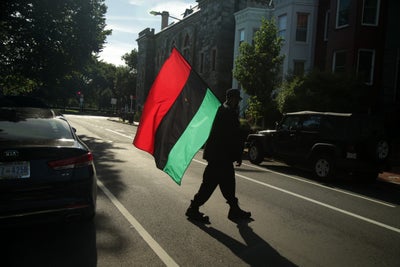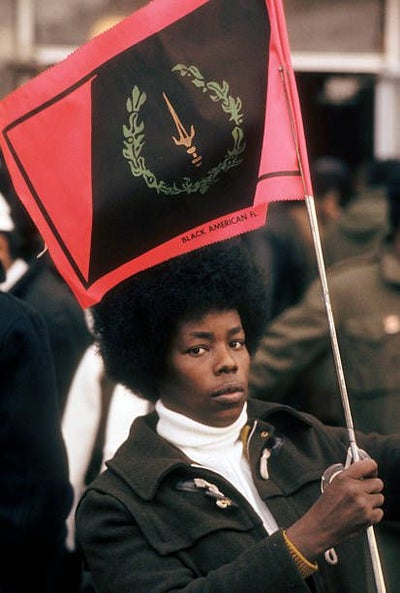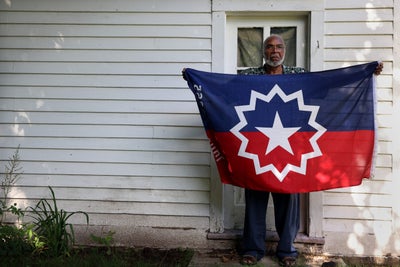At best, flags can be powerful symbols. Flags can represent pride, hope, resilience, history and the future. At worst, they are symbols of hate and can cause fear and trauma. Regardless of usage, such as language and culture, flags are an important aspect of the identity of any group of people. Given the history of black people in the United States - transitioning from property slaves to free American citizens - the journey to establish an identity for oneself was laborious. As black identity is constantly evolving, so do the symbols that represent us.
Read Also: The 30-meter-tall "Amazon" Statue In Benin Honors The Dahomeyan Woman Warriors.
Here is a growing list of flags that have made the black experience into the fabric of American history:
01
Pan-African flag — 1920
Created by Marcus Garvey in 1920, the Pan-African flag is known to be the first flag for Black Americans. The Jamaican political activist and founder of the Universal Negro Improvement Association and African Communities League created the flag to combat racism. It was in response to a hit song called “Every Race Has a Flag but the Coon,” which mocked and stereotyped African Americans. In 1927, Negro World published a 1921 speech from Garvey, stating, “Show me the race or the nation without a flag, and I will show you a race of people without any pride. Aye! In song and mimicry, they have said, ‘Every race has a flag but the coon.’ How true! Aye! But that was said of us four years ago. They can’t say it now.” In 1921, the UNIA published the meaning of the flags colors: red is the color of the blood which men must shed for their redemption and liberty; black is the color of the noble and distinguished race to which we belong; green is the color of the luxuriant vegetation of our Motherland. Now, the Pan-African flag extends beyond the Black American experience as the colors would appear in newly liberated nations like Saint Kitts and Nevis, Kenya, South Sudan, Libya, Angola, Biafra, and Malawi.

02
Black Panther Party flag — 1966
In 1966, comrades Huey Newton and Bobby Seale founded the Black Panther Party for Self-Defense in Oakland, California. That same year, Newton and Seale met Student Nonviolent Coordinating Committee (SNCC) leader Stokely Carmichael, who championed the call for “Black Power” at a conference. At the time, Carmichael was promoting the armed organizing efforts of the Lowndes County Freedom Organization (LCFO). The LCFO’s logo was black panther. According to Red Wedge magazine, Lowndes County had extremely conservative right-wing politics fueled by white racists. Due to high illiteracy rates, the white racists of Lowndes were able to go to court to get a symbol of a rooster put on the ballot so illiterate whites would know how to vote without even being able to read or write. Black people in the town did the same thing; they chose a local varsity mascot of a black panther. Newton and Seale adopted the black panther from Carmichael. However, the panther from Lowndes was too fat for the duo. Newton and Seale asked one of their early recruits, a student-artist, Emory Douglas to redraw the Panther symbol smaller to reflect that the party was about serving the underserved and undernourished.

03
Black American Heritage Flag — 1967
Melvin Charles and Gleason T. Jackson designed the Black American Heritage Flag in Newark, New Jersey. The inspiration was purely birthed out of a lack of representation during parades as a child and not identifying with the American flag. Charles told PBS, that the gold blunted sword invokes pride and the fig wreath symbolizes peace, prosperity, and everlasting life. Following the UNIA, the red represents the bloodshed of Black people, and the black represented the pride in black pigmentation.

04
Juneteenth flag — 1977
With the assistance of illustrator Lisa Jeanna, the Juneteenth flag was created in 1977 by activist Ben Haith, founder of the National Juneteenth Celebration foundation. The red, white, and blue color scheme is a direct homage to both the American flag and the Texas (Lone Star State) flag. Split between a blue and a red stripe, the two colors are meant to replicate a horizon. Blue above and the red is symbolic of the washing away of the ground soaked with blood; the blood which was shed by the African American slaves for the United States. The white five-pointed star inside of a 12-point star, represents a nova, to symbolize the birth of a new star. The new star symbolizes a new beginning for the newly freed African Americans. The flag was updated in 2007 by Haith to include the date, June 19, 1865, marking the last of the enslaved to be freed.

05
13 Stripes flag — 1989
Little can be found about this flag. However, it did appear in Louis Cameron’s “The African American Flag Project.” The 2009 exhibit was a suite of paintings of African American flags with the purpose to explore the dialogue of symbolic representation within the African American community. According to an online archival catalogue, the 13 stripes flag was developed in 1989 in South Central L.A. It is believed to be a private venture. One could argue that the 13 stripes represent either the original colonies of America, or the 13th amendment which abolished slavery. Like other flags, the red, black, and greens colors mirror Garvey’s Pan-African ideology. The yellow or gold stripes might represent the richness of Black people, or the gold from African mines.




